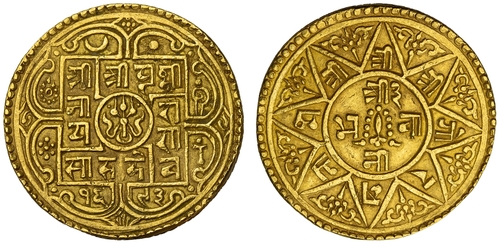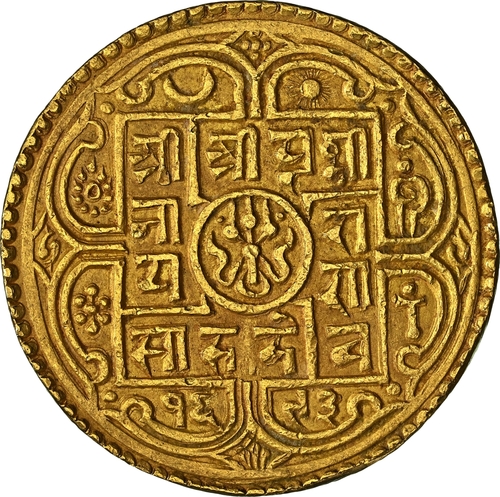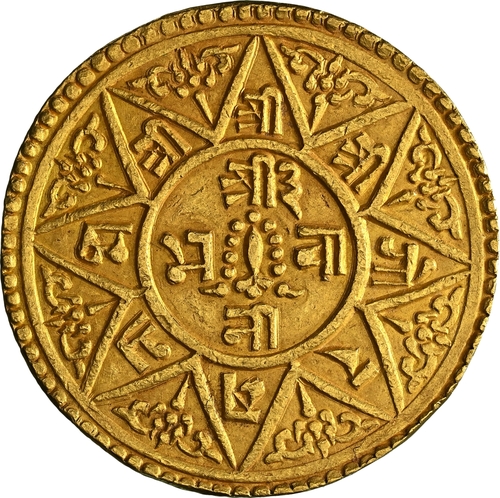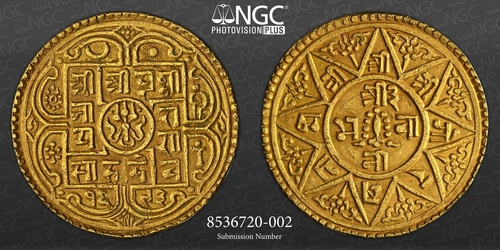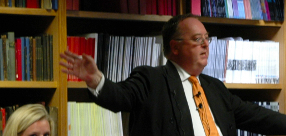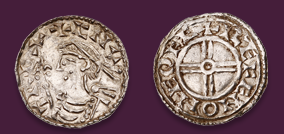Auction: 25088 - The Nicholas Rhodes Collection of Nepalese Coins Part I
Lot: 127
NGC AU | Nepal, Prithvi Narayan Shah (1742-1775), gold Duitole Asarphi, SE 1693 (1772), Obv. square with openings in the middle of the sides, with small circle in the centre, the square being divided into four compartments by the four arms of a swastika, trident in the central circle, around the square, above moon and sun, to left cakra (discus) and lotus, to right conch shell and mace, legend in square Śrī Śrī Śrī P?thvī Nārāya?a Sāha Deva, date below 1693, Rev. circle surrounded by eight-pointed star, ornamental design between each point of the star, sword with garland and legend Śrī 3 Bhavānī in circle, legend in point of star Śrī Śrī Śrī Gorakhanātha , edge obliquely milled, 23.02g (RGV 596; KM 465), areas of smoothing to the edges and a minor bruise, otherwise well struck, about extremely fine and extremely rare, in NGC holder, graded AU DETAILS ~ Edge Filing (Cert. #8536720-002)
Provenance
The Nicholas Rhodes Collection of Nepalese Coins and Medals: Part One
This coin is struck from the same reverse die as the Duitole Asarphis of Surendra, dated NS 1769 (1847) which indicates that it was not struck by Prithvi Narayan, but was struck posthumously and exclusively for Jang Bahadur Rana to present to VIP’s during his journey to Europe in 1850.
The specimen in the British Museum is one of a fine series of gold coins that were presented by Jang Bahadur to Queen Victoria at that time (see RGV, p. 128). The style of the Devanagari letters is not in line with the one found on other coins struck in the name of Prithvi Narayan Shah and corresponds to the style found on the coins struck in the name of Surendra.
Apart from the specimen in the British Museum and the one in the Rhodes collection, Carlo Valdettaro has recorded one coin in his own collection that he had bought in 1974 from P. K. Unni, a dealer from Calcutta who had obtained it "in Bombay from one of the scions of the Rana family." Weight: 22.95 g; diam.: 39,9 mm (Carlo Valdettaro: Miscellanea XXIII of Himalayan Coins in the Collection of C. Valdettaro, manuscript, Dec. 1974.).
The four emblems cakra (disk), gada (mace or club), shankha (conch) and padma (lotus) appear on the obverse of nearly all gold and silver coins of the Shah dynasty. They are the emblems of the four-armed Hindu god Vishnu. The Shah kings of Nepal considered themselves as incarnations of Vishnu, a belief to which the four emblems on the coins allude.
Subject to 20% VAT on Buyer’s Premium. For more information please view Terms and Conditions for Buyers.
Estimate
Starting price
£3200

